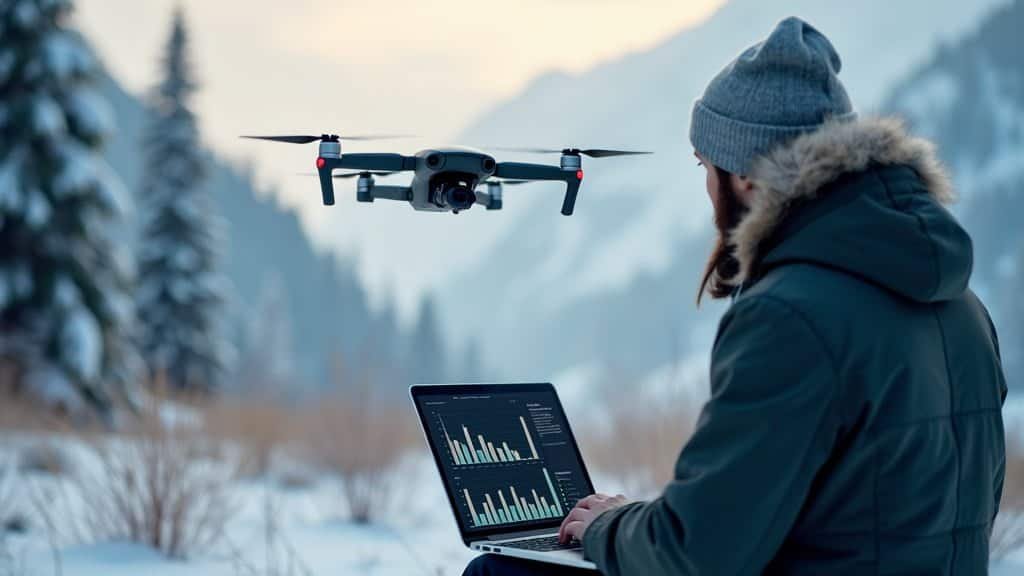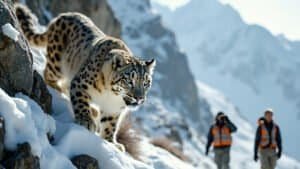Introduction
Advancements in technology have significantly transformed snow leopard research, enabling more precise and effective conservation efforts. From GPS collars that track their movements in real-time to drones offering new perspectives on their elusive habitats, these innovations are crucial for understanding and protecting this endangered species
Artificial intelligence is also making strides, assisting researchers in analyzing data faster and more accurately. In this article, we will explore the latest technological advancements in snow leopard research, focusing on the most impactful tools and methods that are shaping the future of wildlife conservation
How GPS Collars Are Revolutionizing Snow Leopard Tracking
GPS collars have become a game-changer in wildlife research, particularly for elusive and wide-ranging species like the snow leopard
These collars, equipped with advanced GPS technology, provide researchers with accurate, real-time data on the movement patterns, behavior, and territory use of snow leopards, which are notoriously difficult to study due to their remote and rugged habitats
What Are GPS Collars and How Do They Work?
GPS collars are devices attached around an animal’s neck that use the Global Positioning System (GPS) to collect location data at regular intervals. These devices are designed to be lightweight and durable, minimizing any impact on the animal’s natural behavior
The data collected by these collars is transmitted to researchers via satellite or cellular networks, allowing them to track the animal’s movements over time
The collars are typically equipped with various sensors, including accelerometers, which provide additional data on the animal’s activity levels, such as when they are hunting, resting, or traveling
This multi-faceted data collection allows researchers to gain insights not only into where the snow leopards are but also into their behavior and how they interact with their environment
Benefits of GPS Collars in Snow Leopard Research
The introduction of GPS collars has revolutionized snow leopard research in several ways:
Precise Tracking: The most significant benefit of GPS collars is the precise and continuous tracking of snow leopards. Researchers can monitor the movements of individual leopards over long periods, helping them understand migration patterns, territorial ranges, and habitat preferences
Behavioral Insights: By analyzing movement data, researchers can infer behavioral patterns such as hunting habits, breeding behavior, and interactions with other snow leopards. This information is crucial for understanding the ecological role of snow leopards and how they affect their environment
Conservation Planning: The data gathered from GPS collars is invaluable for conservation efforts. It helps identify critical habitats that need protection and informs the creation of wildlife corridors that allow safe passage for snow leopards between fragmented habitats. This is particularly important in regions where human-wildlife conflict is a concern, as it allows for better management of these interactions
Impact of Climate Change: Snow leopards inhabit some of the most extreme environments on Earth, and their habitats are increasingly affected by climate change. GPS tracking helps researchers monitor how snow leopards are responding to these changes, such as shifts in their range or alterations in their prey availability. This data is essential for developing adaptive conservation strategies that can mitigate the impacts of climate change on snow leopard populations
Case Studies: GPS Collar Success Stories
Several case studies highlight the success of using GPS collars in snow leopard research:
Mongolia: In Mongolia’s Tost Mountains, GPS collars have provided crucial data on snow leopard movements, revealing that they roam across vast territories that overlap with human settlements. This information has been instrumental in creating protected areas and reducing conflicts between snow leopards and livestock herders
India: In the Indian Himalayas, GPS-collared snow leopards have helped researchers identify critical habitats and migration corridors. This has led to the implementation of conservation measures, such as establishing wildlife corridors that reduce habitat fragmentation and enhance connectivity between populations
Pakistan: In Pakistan’s Gilgit-Baltistan region, GPS collars have been used to track snow leopards in one of the most remote and inaccessible parts of their range. The data collected has been used to engage local communities in conservation efforts, promoting coexistence and reducing poaching incidents
The use of GPS collars represents a significant technological advancement in snow leopard research, providing invaluable data that is helping to protect and conserve this elusive species. However, it is not without challenges
The high cost of the technology, the need for frequent collar maintenance, and the difficulties of capturing and collaring snow leopards in rugged terrain are ongoing challenges that researchers must navigate
The continued development and deployment of GPS collars, combined with other technologies like drones and AI, are essential for deepening our understanding of snow leopards and ensuring their survival in the wild
The Role of Drones in Monitoring Snow Leopard Populations
Drones, or unmanned aerial vehicles (UAVs), have emerged as a powerful tool in wildlife research, offering new perspectives and capabilities that were previously unimaginable
In the study of snow leopards, drones are particularly valuable due to their ability to access and survey the remote, rugged terrains that these elusive cats inhabit. By providing high-resolution imagery and real-time data, drones are revolutionizing the way researchers monitor snow leopard populations and their habitats
How Drones Are Used in Wildlife Monitoring
Drones have transformed wildlife monitoring by providing researchers with a cost-effective and efficient way to survey large and difficult-to-access areas. In snow leopard research, drones are used primarily for aerial surveys, habitat mapping, and population monitoring:
Aerial Surveys: Drones can be deployed to conduct aerial surveys over vast areas of snow leopard habitat. These surveys are crucial for identifying potential snow leopard territories, tracking changes in habitat due to natural or human-induced factors, and monitoring snow leopard prey populations. The ability to cover large areas quickly and with minimal disturbance to the wildlife makes drones an invaluable tool in this regard
Habitat Mapping: High-resolution cameras mounted on drones capture detailed images of the landscape, which can be used to create accurate habitat maps. These maps are essential for understanding the distribution of snow leopards and their prey, as well as for identifying critical habitats that require protection. Drones can also monitor changes in these habitats over time, such as the effects of climate change, deforestation, or human encroachment
Population Monitoring: Drones equipped with thermal imaging cameras can detect the presence of snow leopards and their prey by their body heat, even in low-light or challenging weather conditions. This capability is particularly useful in the dense or rugged terrains where snow leopards are most commonly found, as it allows researchers to monitor populations without the need for direct sightings, which are often rare
Advantages of Drone Technology in Snow Leopard Research
The use of drones in snow leopard research offers several key advantages:
Access to Remote Areas: Snow leopards inhabit some of the most remote and inaccessible regions on Earth, including the high-altitude mountains of Central Asia. Traditional methods of monitoring these areas, such as on-foot surveys or camera traps, are often labor-intensive, time-consuming, and limited in scope. Drones can easily access these areas, providing researchers with a broader view of snow leopard habitats
Non-Invasive Monitoring: One of the significant benefits of using drones is their ability to monitor wildlife without direct human interference. This non-invasive approach is particularly important for studying snow leopards, as it minimizes the risk of disturbing these shy and elusive animals, which could otherwise lead to skewed data or cause the animals to alter their natural behavior
Cost-Effectiveness: While the initial investment in drone technology can be substantial, the overall cost of conducting surveys and monitoring with drones is often lower than traditional methods. Drones reduce the need for extensive field teams and prolonged expeditions, making long-term monitoring more feasible and cost-effective
Real-Time Data Collection: Drones can transmit real-time data to researchers, allowing for immediate analysis and decision-making. This capability is especially valuable in situations where quick action is needed, such as in the case of detecting illegal poaching activities or responding to sudden changes in habitat conditions
Challenges and Limitations of Using Drones
Despite the many advantages, the use of drones in snow leopard research is not without challenges:
Technical Limitations: Drones have limited battery life, which restricts their flight time and range. In the high-altitude environments where snow leopards live, the reduced air density can further impact drone performance, making it challenging to maintain stability and control. Additionally, extreme weather conditions such as high winds, snow, and low temperatures can limit drone operations and the quality of data collected
Regulatory Hurdles: The use of drones is subject to strict regulations in many countries, particularly in protected areas where snow leopards are found. Obtaining the necessary permits and adhering to local laws can be time-consuming and complex, potentially delaying research activities
Ethical Considerations: While drones are less invasive than other monitoring methods, there is still a risk that they could disturb wildlife, particularly if flown too close to animals or during sensitive periods such as breeding. Researchers must balance the need for data with the potential impact on the species being studied
Data Management: The high volume of data generated by drone surveys, especially high-resolution imagery and video, requires significant storage and processing capabilities. Analyzing this data can be time-consuming and may require specialized software and expertise
Despite these challenges, the use of drones in snow leopard research continues to grow, driven by ongoing technological advancements and the pressing need for better conservation strategies
As drone technology evolves, it is likely to become an even more integral part of wildlife monitoring, providing researchers with the tools they need to protect and conserve snow leopards in their natural habitats
Artificial Intelligence in Snow Leopard Research
Artificial intelligence (AI) is rapidly becoming a crucial tool in wildlife research, including the study of snow leopards
By processing vast amounts of data quickly and accurately, AI is helping researchers uncover patterns and insights that were previously difficult or impossible to detect. From image recognition to predictive modeling, AI is enhancing our ability to monitor and protect snow leopards in their natural habitats
Introduction to AI in Wildlife Research
Artificial intelligence encompasses a range of technologies that enable machines to perform tasks that typically require human intelligence, such as learning, reasoning, and problem-solving. In wildlife research, AI is being used to automate data collection, analyze complex datasets, and make predictions based on patterns identified in the data
For snow leopard research, AI applications are particularly valuable given the challenges associated with studying these elusive animals. Snow leopards are difficult to observe directly due to their remote habitats and solitary nature
However, AI can process and analyze the data collected from various sources, such as camera traps, drones, and GPS collars, providing insights that might otherwise go unnoticed
Applications of AI in Snow Leopard Conservation
Image Recognition and Classification
One of the most significant applications of AI in snow leopard research is image recognition. Camera traps deployed in snow leopard habitats capture thousands of images, many of which contain other animals or are empty due to environmental triggers like wind or snow. Manually sorting through these images is time-consuming and labor-intensive
AI-powered image recognition software can automatically identify snow leopards in camera trap images, filtering out irrelevant data and reducing the time required for analysis. These systems can be trained to recognize individual snow leopards based on their unique coat patterns, enabling researchers to track specific animals over time and monitor their movements and behaviors
For example, the Snow Leopard Trust has implemented AI algorithms to analyze images from camera traps in multiple countries across snow leopard habitats. These AI systems have dramatically improved the efficiency and accuracy of population monitoring, helping to estimate snow leopard numbers more reliably
Predictive Modeling
AI is also used in predictive modeling to anticipate changes in snow leopard populations and habitats. By analyzing historical data on snow leopard movements, prey availability, and environmental conditions, AI models can predict how snow leopard populations might respond to factors such as climate change, habitat fragmentation, or human-wildlife conflict
These models are invaluable for conservation planning, as they allow researchers and conservationists to test different scenarios and develop strategies that can mitigate potential threats to snow leopards. For instance, AI models might predict how changes in prey distribution due to climate change could impact snow leopard hunting patterns, enabling proactive conservation measures.
Acoustic Monitoring
In addition to visual data, AI is being applied to acoustic monitoring in snow leopard habitats. Snow leopards are known to communicate through vocalizations, especially during the mating season. AI algorithms can analyze audio recordings from remote sensors, identifying snow leopard calls and distinguishing them from other sounds in the environment
This acoustic data provides another layer of information about snow leopard presence and behavior, complementing the data gathered from camera traps and GPS collars. AI-powered acoustic monitoring is particularly useful in dense or rugged terrains where visual observation is challenging
Future Potential of AI in Protecting Snow Leopards
As AI technology continues to evolve, its applications in snow leopard research are likely to expand. Future advancements might include:
Real-Time Monitoring and Alerts
AI could enable real-time monitoring of snow leopard populations, with systems that automatically send alerts when unusual behavior is detected, such as changes in movement patterns that could indicate illness, injury, or the presence of poachers. This real-time data could allow for quicker responses to potential threats, improving the effectiveness of conservation efforts
Integration with Other Technologies
AI has the potential to integrate with other technologies, such as drones and GPS collars, to create comprehensive monitoring systems. For example, AI could analyze data from multiple sources simultaneously, providing a more holistic view of snow leopard behavior and habitat use. This integration could also enhance predictive models, making them more accurate and useful for long-term conservation planning.
Community-Based Conservation
AI can also play a role in community-based conservation efforts. By making data collection and analysis more accessible, AI tools could empower local communities to participate in snow leopard monitoring and protection. For example, AI-driven mobile apps could allow herders and villagers to report snow leopard sightings or track movements, contributing valuable data to conservation projects.
Challenges and Ethical Considerations
While AI offers significant benefits, it also presents challenges and ethical considerations. The reliance on AI for data analysis raises concerns about data privacy, especially when working with local communities. Additionally, there is a risk of over-reliance on AI, where important contextual information provided by human expertise might be overlooked
Moreover, the implementation of AI technologies requires substantial financial resources and technical expertise, which may not be readily available in all regions where snow leopards are found
Ensuring that AI applications are accessible and beneficial to all stakeholders involved in snow leopard conservation is a critical consideration for the future
Innovative Techniques for Estimating Snow Leopard Populations
Estimating the population of snow leopards is a complex and challenging task due to their elusive nature and the rugged, remote habitats they occupy
Traditional methods like direct observation are often impractical, so researchers have developed innovative techniques to obtain more accurate estimates of snow leopard populations
These methods, which include camera traps, genetic analysis, and the integration of multiple technologies, are crucial for effective conservation planning and management
Camera Traps and Their Impact on Population Studies
Camera traps have become one of the most reliable tools for estimating snow leopard populations. These motion-activated cameras are strategically placed in areas where snow leopards are known or suspected to roam, capturing images and videos when an animal passes by
Identification of Individual Leopards
Snow leopards have unique rosette patterns on their fur, much like a human fingerprint. By analyzing the images captured by camera traps, researchers can identify individual snow leopards and track their movements over time
This method allows for the estimation of population density by identifying the number of unique individuals within a specific area
For example, a study conducted in Nepal’s Annapurna Conservation Area used camera traps to identify individual snow leopards, leading to one of the first reliable population estimates in the region. The data collected from camera traps provided critical insights into the density and distribution of snow leopards, informing conservation strategies
Long-Term Monitoring
Camera traps also enable long-term monitoring of snow leopard populations. By maintaining a network of camera traps across different seasons and years, researchers can observe population trends, such as increases or declines in numbers, and detect changes in habitat use
This ongoing data collection is essential for assessing the effectiveness of conservation interventions and adapting strategies as needed
Behavioral Insights
In addition to population estimates, camera traps provide valuable information on snow leopard behavior, such as hunting patterns, interactions with other species, and territoriality. These insights contribute to a more comprehensive understanding of snow leopard ecology, which is essential for developing targeted conservation measures
Genetic Analysis Methods for Accurate Estimations
Genetic analysis is another powerful tool for estimating snow leopard populations, particularly when used in conjunction with camera traps and other technologies. By analyzing genetic material, such as DNA from scat (feces), hair, or tissue samples, researchers can gain insights into the genetic diversity, relatedness, and population structure of snow leopards
Non-Invasive DNA Sampling
Collecting DNA samples from snow leopards is often done using non-invasive methods, such as gathering scat or hair left behind in the environment
This approach is particularly valuable in areas where snow leopards are difficult to observe directly. DNA extracted from these samples can be analyzed to identify individual snow leopards, much like with camera traps
A study in the Altai Mountains of Russia used non-invasive genetic sampling to estimate the local snow leopard population. The researchers collected scat samples from various locations and used genetic markers to identify individual leopards
This method provided a more accurate population estimate than traditional observation methods and helped assess the genetic health of the population
Genetic Mark-Recapture Techniques
Genetic analysis also enables the use of mark-recapture techniques, a method commonly used in wildlife research. In this context, “marking” refers to identifying individuals based on their unique genetic profiles
By “recapturing” (re-sampling) these individuals through subsequent DNA collections, researchers can estimate population size based on the proportion of re-sampled individuals
This technique was effectively applied in the transboundary region of the Himalayas, where researchers used genetic mark-recapture to estimate snow leopard populations across different countries. The data from these studies have been instrumental in developing cross-border conservation strategies
Assessing Genetic Diversity
Genetic analysis not only helps estimate population size but also provides insights into the genetic diversity of snow leopard populations. Maintaining genetic diversity is crucial for the long-term survival of the species, as it allows populations to adapt to changing environmental conditions and resist diseases
Research in Mongolia’s South Gobi region revealed that the genetic diversity of snow leopards in the area was lower than expected, raising concerns about the long-term viability of the population
This finding has led to increased efforts to connect isolated populations and protect critical habitats that facilitate gene flow between groups
Combining Multiple Technologies for Better Results
To improve the accuracy of population estimates, researchers are increasingly combining multiple technologies, such as camera traps, genetic analysis, and GPS tracking
This integrated approach provides a more comprehensive view of snow leopard populations and helps address the limitations of individual methods
Integrated Population Models
Integrated Population Models (IPMs) combine data from various sources, including camera traps, genetic analysis, and field observations, to estimate population size and dynamics more accurately. These models can incorporate information on survival rates, reproduction, and movement patterns, providing a holistic view of snow leopard populations
For example, in the Kangchenjunga Landscape, which spans parts of Nepal, India, and Bhutan, researchers used an IPM that combined camera trap data, genetic samples, and local knowledge
This approach resulted in a more robust population estimate and provided valuable insights into the factors influencing snow leopard survival and reproduction
Remote Sensing and GIS
Remote sensing and Geographic Information Systems (GIS) are also being integrated with population estimation techniques to map snow leopard habitats and predict their distribution. By analyzing satellite imagery and environmental data, researchers can identify potential snow leopard habitats and prioritize areas for conservation
In China’s Qinghai-Tibet Plateau, researchers used remote sensing to map snow leopard habitats and combined this data with camera trap and genetic analysis results. This integrated approach helped identify key areas for snow leopard conservation and guided the establishment of new protected areas
Collaborative Approaches
Collaboration between different research teams and the use of shared data platforms are enhancing the accuracy of snow leopard population estimates. By pooling data from multiple sources and regions, researchers can develop more comprehensive models and ensure that conservation strategies are based on the best available science
The Global Snow Leopard and Ecosystem Protection Program (GSLEP), for instance, has facilitated collaboration between researchers across the snow leopard’s range, leading to more accurate population assessments and coordinated conservation efforts
Technological Advances in Snow Leopard Habitat Protection
Protecting the habitat of snow leopards is crucial for the survival of this elusive species, as their natural environments are increasingly threatened by human activities and climate change
Recent technological advances are playing a pivotal role in monitoring and preserving snow leopard habitats, enabling conservationists to take proactive measures to mitigate threats and enhance habitat connectivity
Monitoring Habitat Changes with Technology
One of the primary challenges in snow leopard conservation is the ability to monitor vast and remote habitats, which often span multiple countries and are difficult to access
Technological innovations are addressing this challenge by providing tools that can track and analyze habitat changes over time
Satellite Remote Sensing
Satellite remote sensing is a powerful tool for monitoring snow leopard habitats on a large scale. By analyzing satellite images, researchers can detect changes in land cover, vegetation, and snow cover, which are all critical indicators of habitat quality
Remote sensing allows conservationists to monitor these changes in near real-time, making it possible to identify and respond to threats such as deforestation, mining, and infrastructure development
For example, in the Tien Shan Mountains of Central Asia, satellite remote sensing has been used to map snow leopard habitats and monitor changes due to human activities
This data has been instrumental in guiding conservation efforts, such as the designation of protected areas and the creation of wildlife corridors that ensure snow leopards can move freely between habitats
Geographic Information Systems (GIS)
GIS technology is used to map and analyze snow leopard habitats, integrating data from various sources such as satellite imagery, GPS tracking, and field surveys. GIS helps researchers identify critical habitats, understand habitat connectivity, and assess the impacts of environmental changes on snow leopard populations
In the Himalayas, GIS has been employed to model snow leopard habitats and predict how these areas might shift due to climate change. This information is crucial for anticipating future conservation needs and ensuring that snow leopard habitats remain intact and connected
Climate Modeling
Climate change poses a significant threat to snow leopard habitats, as rising temperatures and changing precipitation patterns can alter the distribution of both snow leopards and their prey
Climate modeling is being used to predict how these changes will impact snow leopard habitats and to develop strategies for mitigating these effects
In Mongolia, climate models have been used to predict how warming temperatures might shift snow leopard habitats to higher altitudes, potentially leading to habitat loss and increased competition with other species. These models are helping conservationists prioritize areas for protection and restoration, ensuring that snow leopards have access to suitable habitats in the future
Climate Change and Snow Leopard Habitats
The impacts of climate change on snow leopard habitats are becoming increasingly apparent, with changes in temperature, precipitation, and snow cover affecting both the availability of prey and the suitability of habitats. Understanding these impacts is essential for developing effective conservation strategies
Shifts in Habitat Range
Climate change is expected to push snow leopard habitats to higher altitudes as temperatures rise and snow lines retreat. This shift could result in the loss of lower-altitude habitats that are crucial for snow leopards during certain seasons
Additionally, the compression of suitable habitats into smaller areas at higher altitudes could lead to increased competition with other species, such as ibex and Himalayan tahr, for food and space
Researchers are using climate models to predict these shifts and identify potential refugia—areas that will remain suitable for snow leopards even as the climate changes. Protecting these areas and ensuring that they are connected to other habitats is a key focus of conservation efforts
Impact on Prey Availability
Snow leopards rely on a stable prey base, including species such as blue sheep, ibex, and marmots. Climate change can affect the distribution and abundance of these prey species, either by altering their habitats or by impacting the vegetation they rely on for food
A decline in prey availability could force snow leopards to expand their range, increasing the likelihood of human-wildlife conflict as they come into closer contact with livestock
Conservationists are using technology to monitor prey populations and model how climate change might affect them. This information is crucial for developing strategies to maintain healthy prey populations and reduce the risk of snow leopards turning to livestock as a food source
Human-Wildlife Conflict
As snow leopard habitats shift due to climate change, there is a growing risk of increased human-wildlife conflict. Snow leopards may move closer to human settlements in search of food, leading to predation on livestock and retaliatory killings by herders
Technology is being used to mitigate these conflicts through early warning systems, predator-proof enclosures, and community-based monitoring programs
In Kyrgyzstan, for example, GPS collars on snow leopards are used to track their movements and send alerts to herders when a snow leopard is near their grazing areas. This allows herders to take preventive measures, such as moving their livestock to safer locations or using predator deterrents
Community Involvement Enhanced by Technology
Effective snow leopard habitat protection often involves the cooperation and participation of local communities, who are the stewards of the land where snow leopards live
Technology is playing a crucial role in engaging communities in conservation efforts, providing them with the tools and knowledge needed to protect snow leopard habitats
Participatory Mapping
Participatory mapping is a process in which local communities are involved in creating maps of their lands, including areas that are important for snow leopard conservation. By using GIS and other mapping technologies, communities can identify key habitats, migration corridors, and areas of human-wildlife conflict
In the Pamir Mountains of Tajikistan, participatory mapping has been used to engage local communities in snow leopard conservation. Community members worked with researchers to map critical snow leopard habitats and identify areas where conservation efforts should be focused
This collaborative approach has led to the establishment of community-managed conservation areas and has strengthened local support for snow leopard protection
Mobile Technology for Monitoring
Mobile technology is being increasingly used to involve communities in snow leopard monitoring. Smartphone apps and other mobile tools allow herders, rangers, and local residents to report snow leopard sightings, track movements, and document instances of human-wildlife conflict
This real-time data collection is invaluable for researchers and helps to ensure that conservation measures are based on the most current information
The Snow Leopard Trust has developed a mobile app that enables herders to record snow leopard sightings and monitor livestock losses. This data is shared with researchers and conservationists, who use it to improve snow leopard protection strategies and reduce conflicts with local communities
Education and Awareness Programs
Technology is also being used to raise awareness about snow leopard conservation among local communities
Educational programs that use digital media, such as videos, online courses, and interactive apps, are helping to spread knowledge about the importance of snow leopard habitats and the need for conservation
In Nepal, the Snow Leopard Conservancy has developed an educational app that teaches schoolchildren about snow leopards and their habitats. The app includes games, quizzes, and interactive maps, making learning about snow leopard conservation fun and engaging. By reaching the younger generation, these programs aim to foster a long-term commitment to snow leopard conservation within local communities
Conclusion
The latest technological advancements are significantly enhancing our ability to study and protect snow leopards, a species that has long been shrouded in mystery due to its elusive nature and the harsh environments it inhabits
From GPS collars that provide real-time tracking data to drones that offer new perspectives on their habitats, these technologies are revolutionizing snow leopard research. Artificial intelligence is further amplifying our capacity to analyze vast amounts of data, leading to more accurate population estimates and predictive models
Innovative methods like camera traps and genetic analysis are providing clearer insights into population dynamics, while integrated approaches combining these tools offer a comprehensive understanding of snow leopard ecology
In the realm of habitat protection, technologies such as satellite remote sensing, GIS, and climate modeling are proving indispensable for monitoring changes and planning effective conservation strategies
Community involvement, enhanced by mobile technology and participatory mapping, ensures that those living alongside snow leopards are actively engaged in their conservation. As these technologies continue to advance, they will undoubtedly play a critical role in ensuring the survival of snow leopards in the wild, helping us to safeguard both the species and the fragile ecosystems they call home







